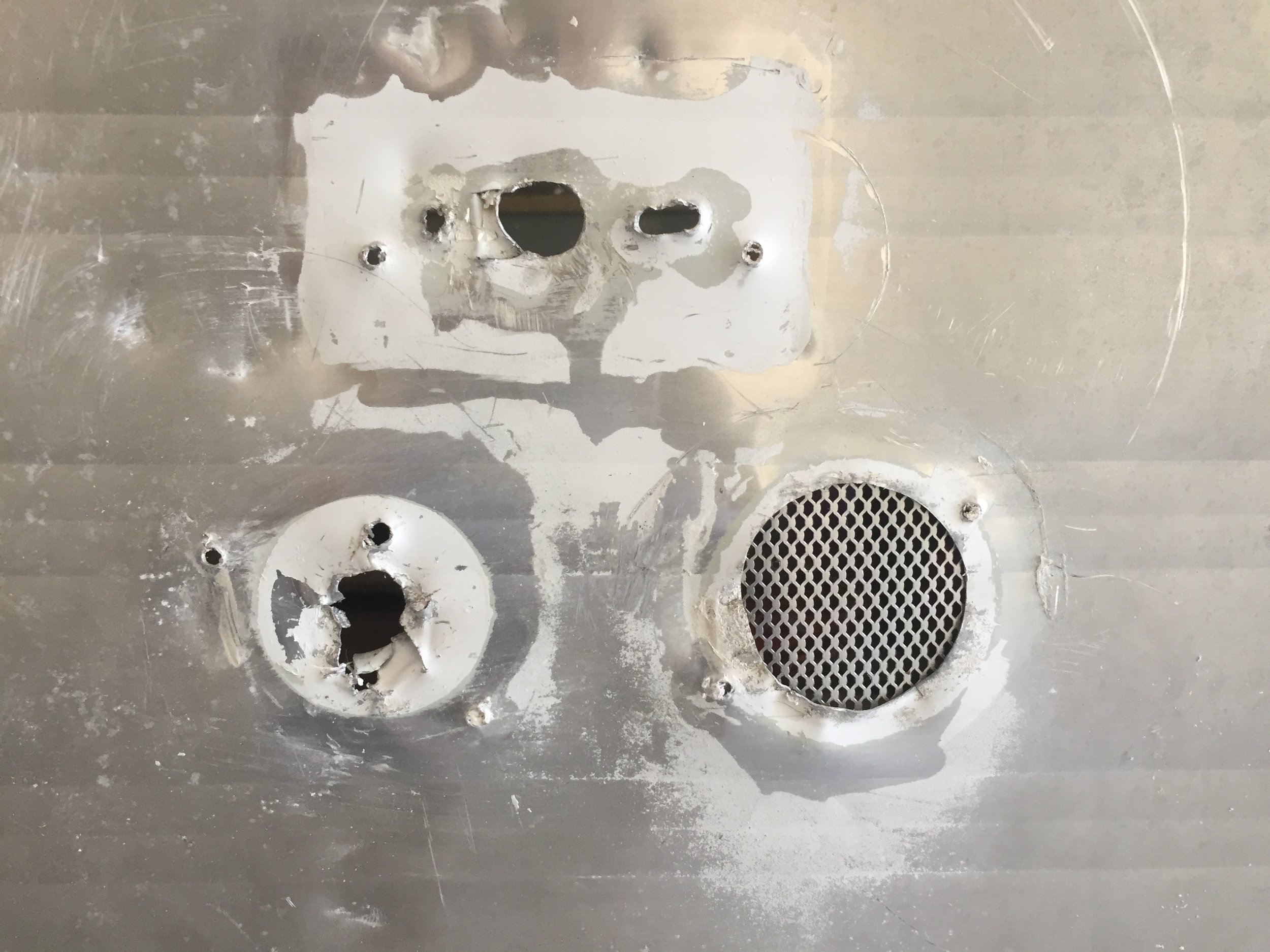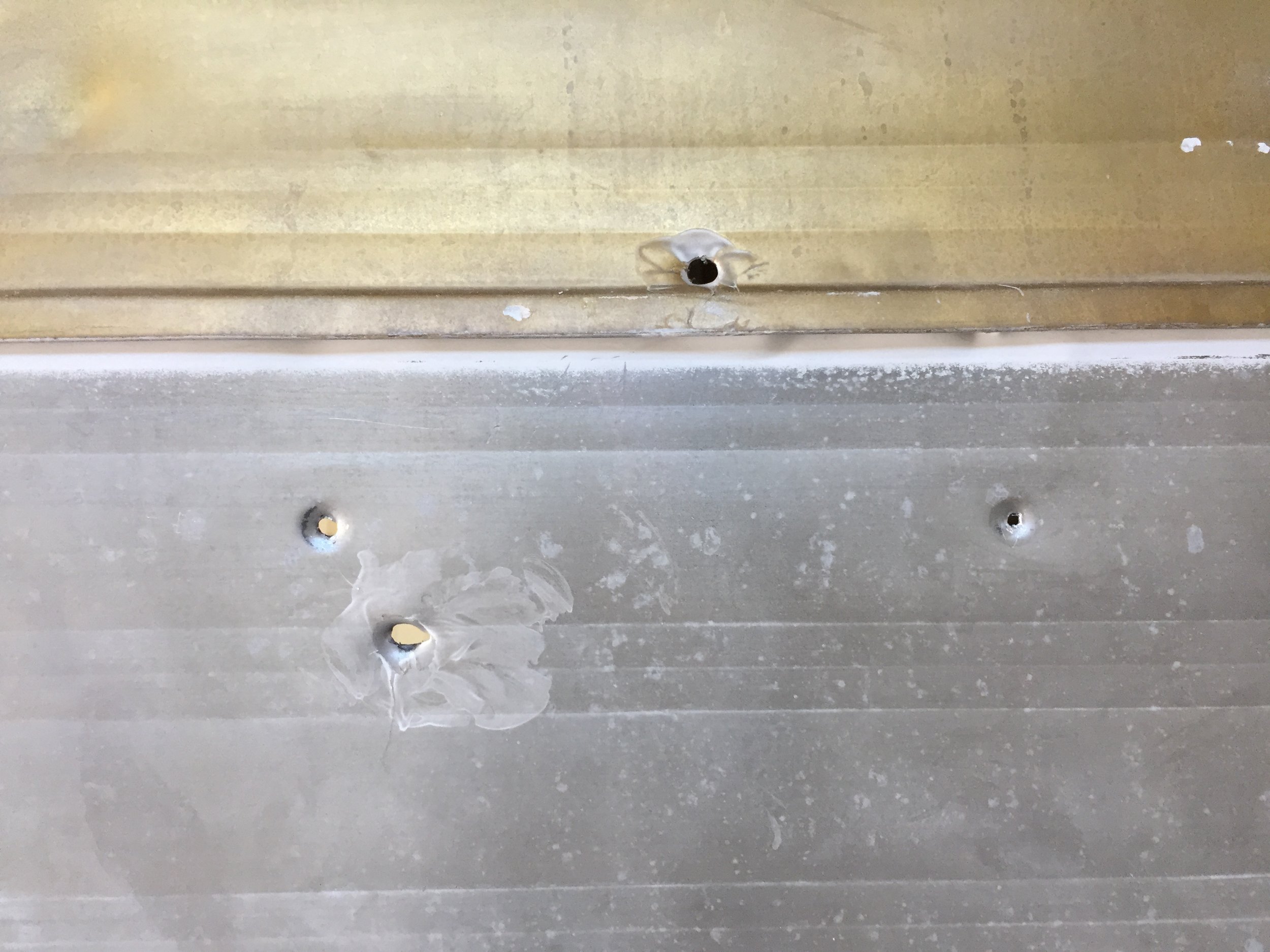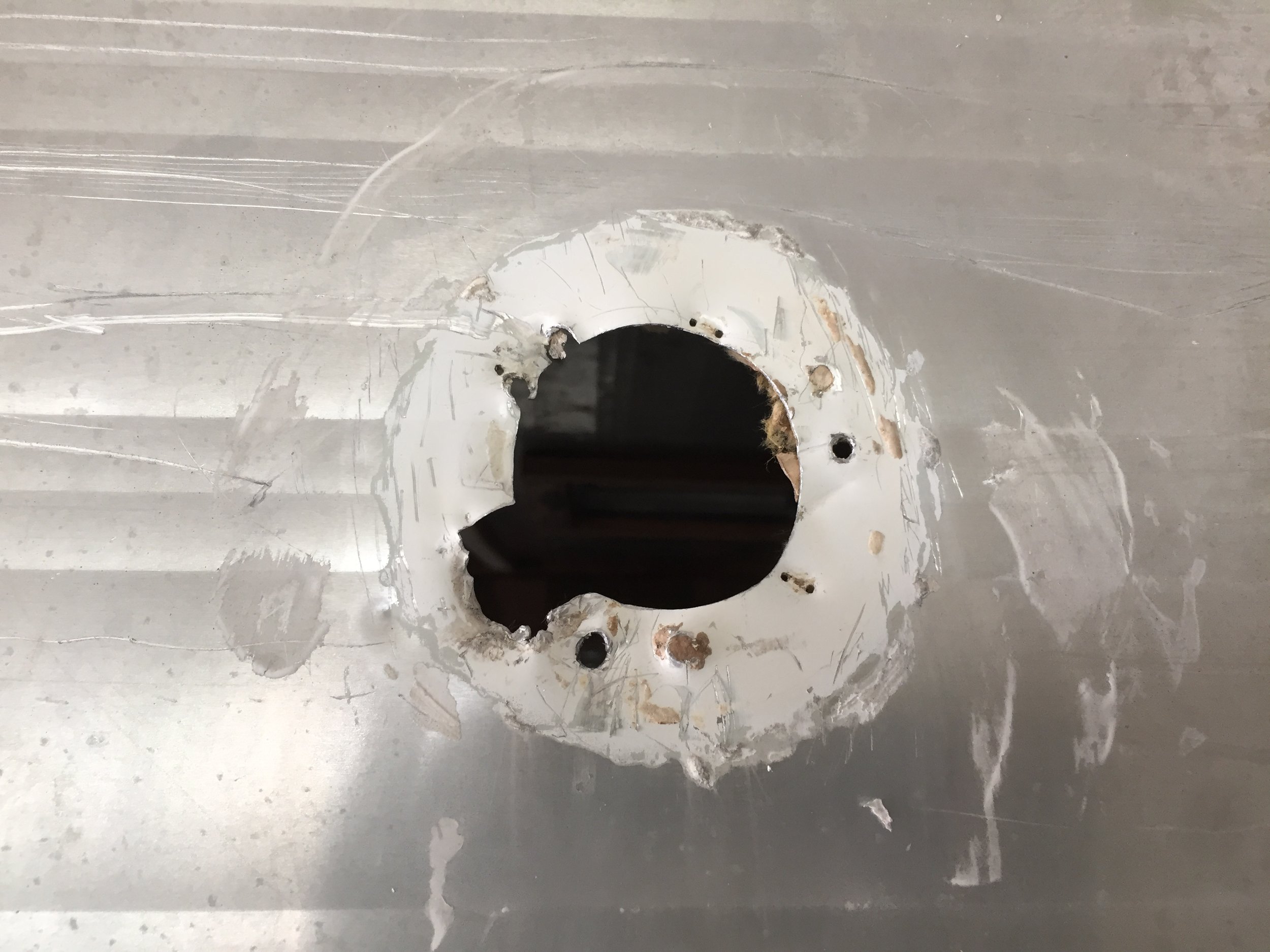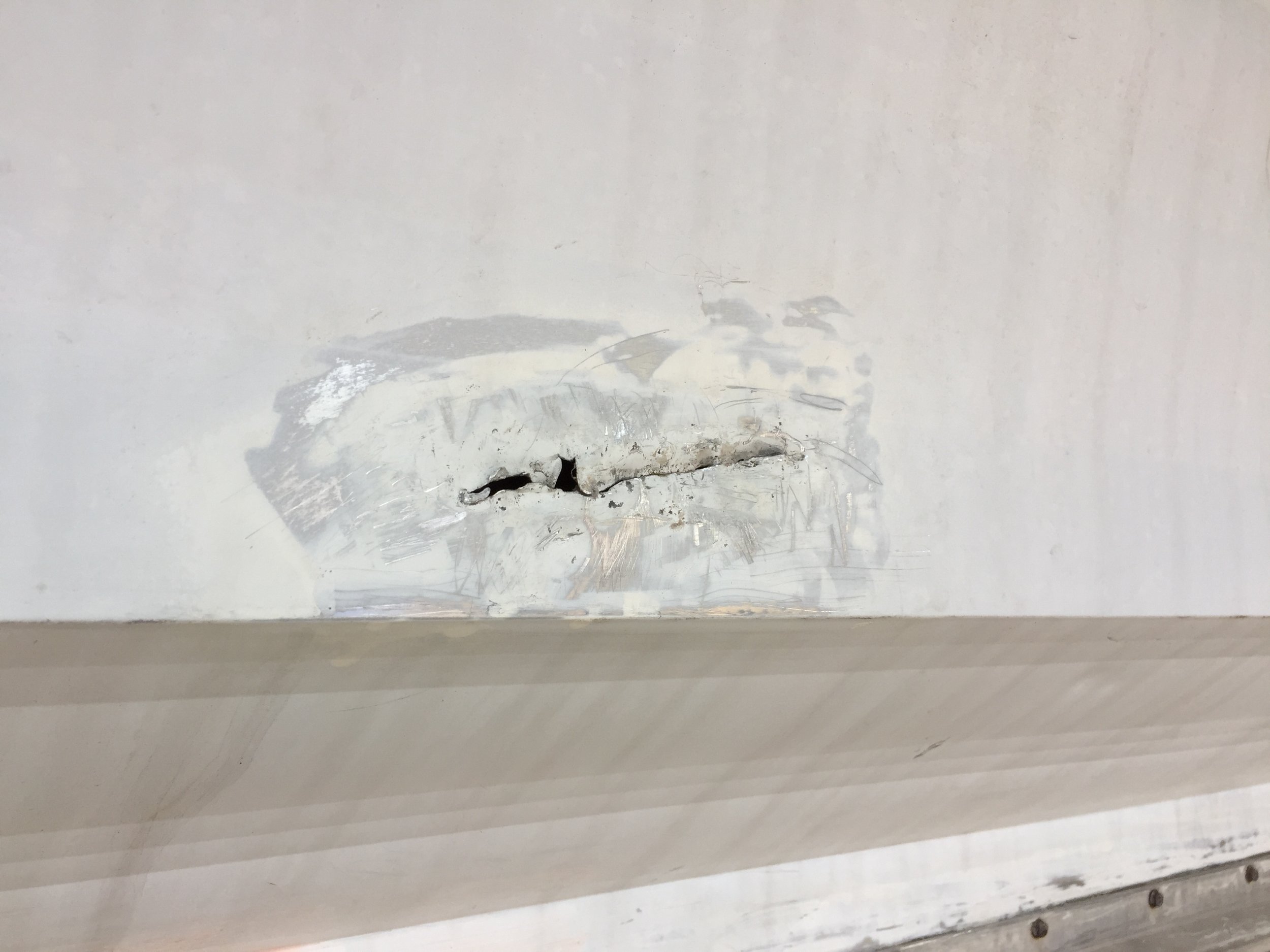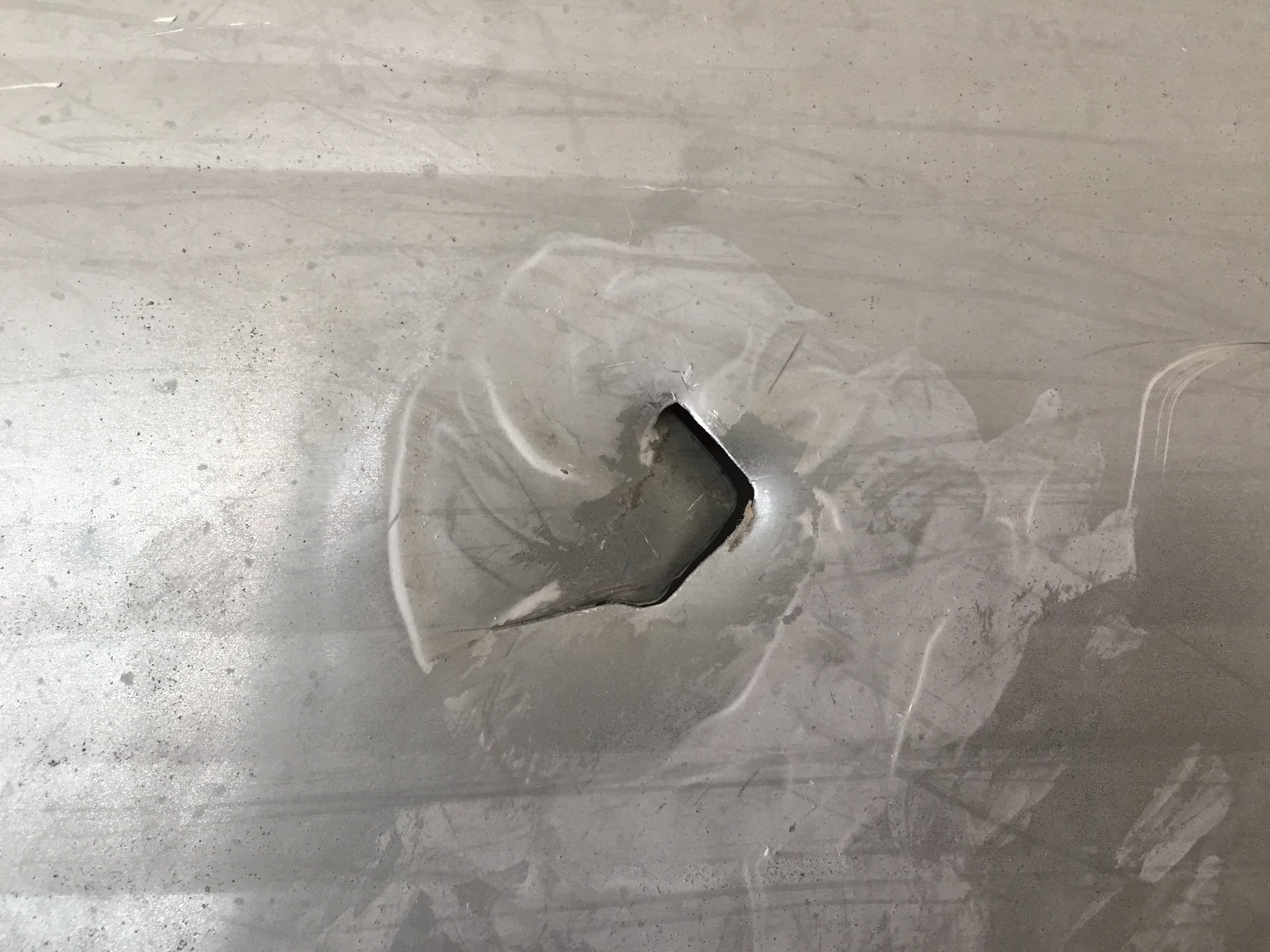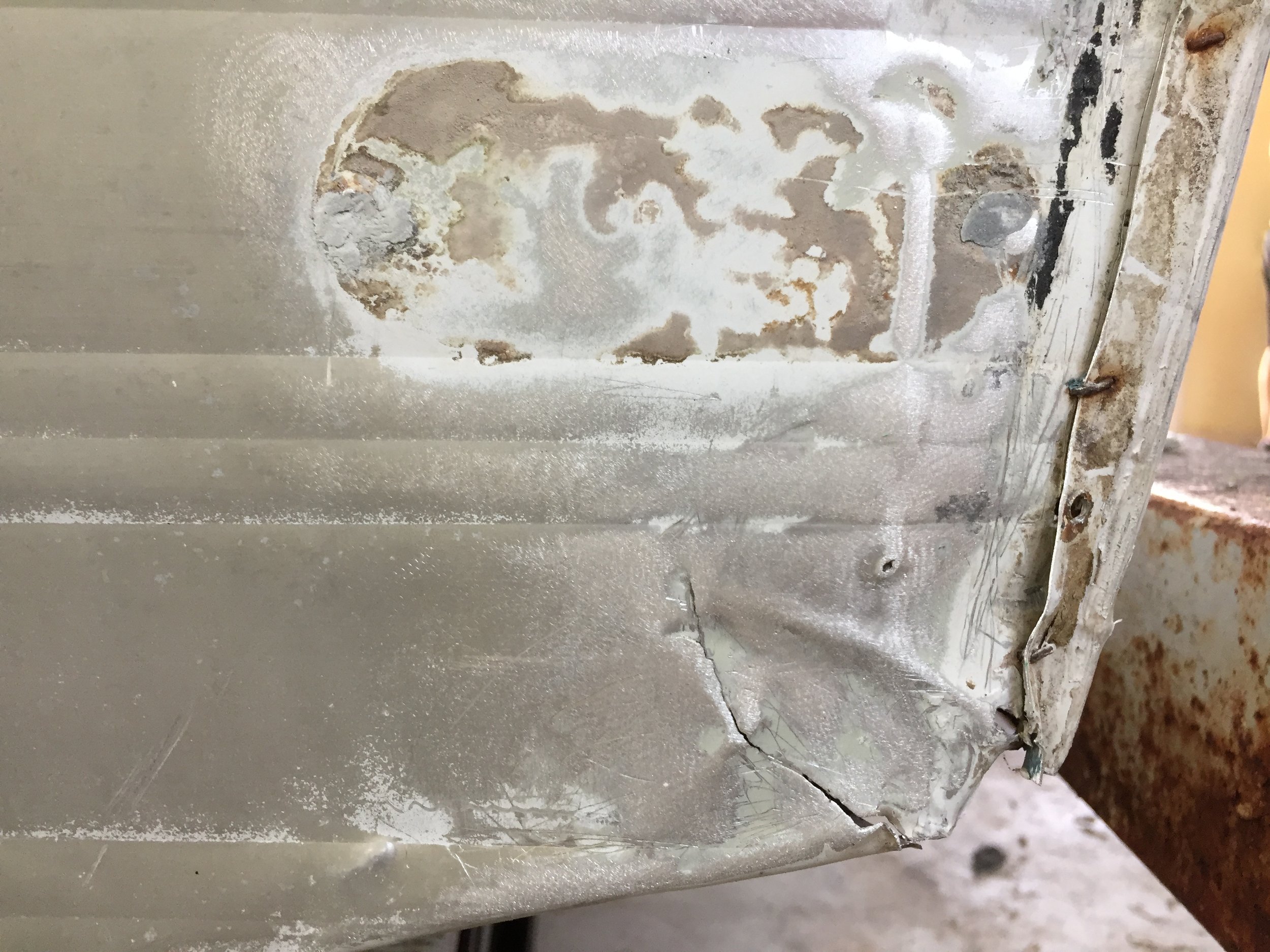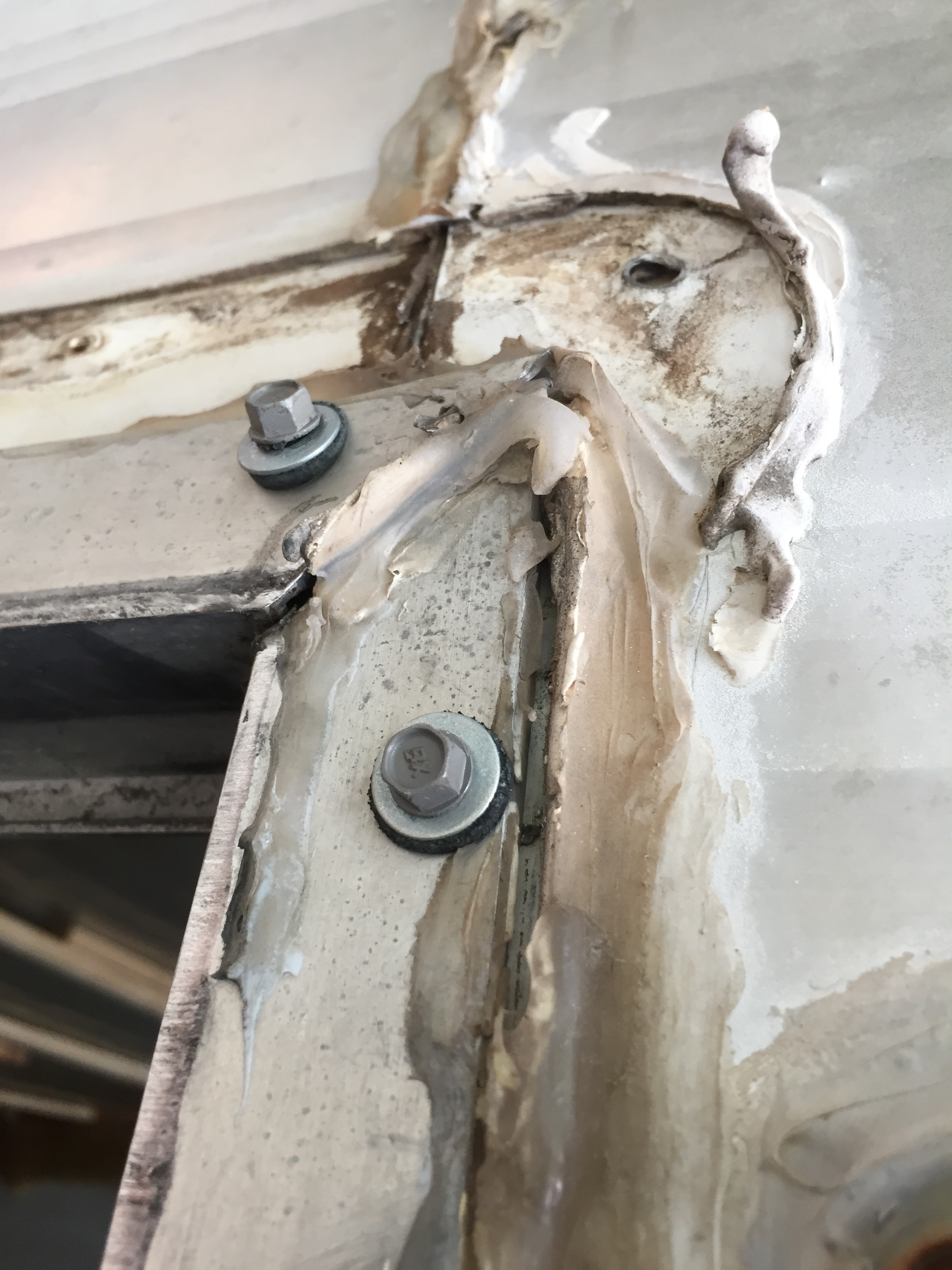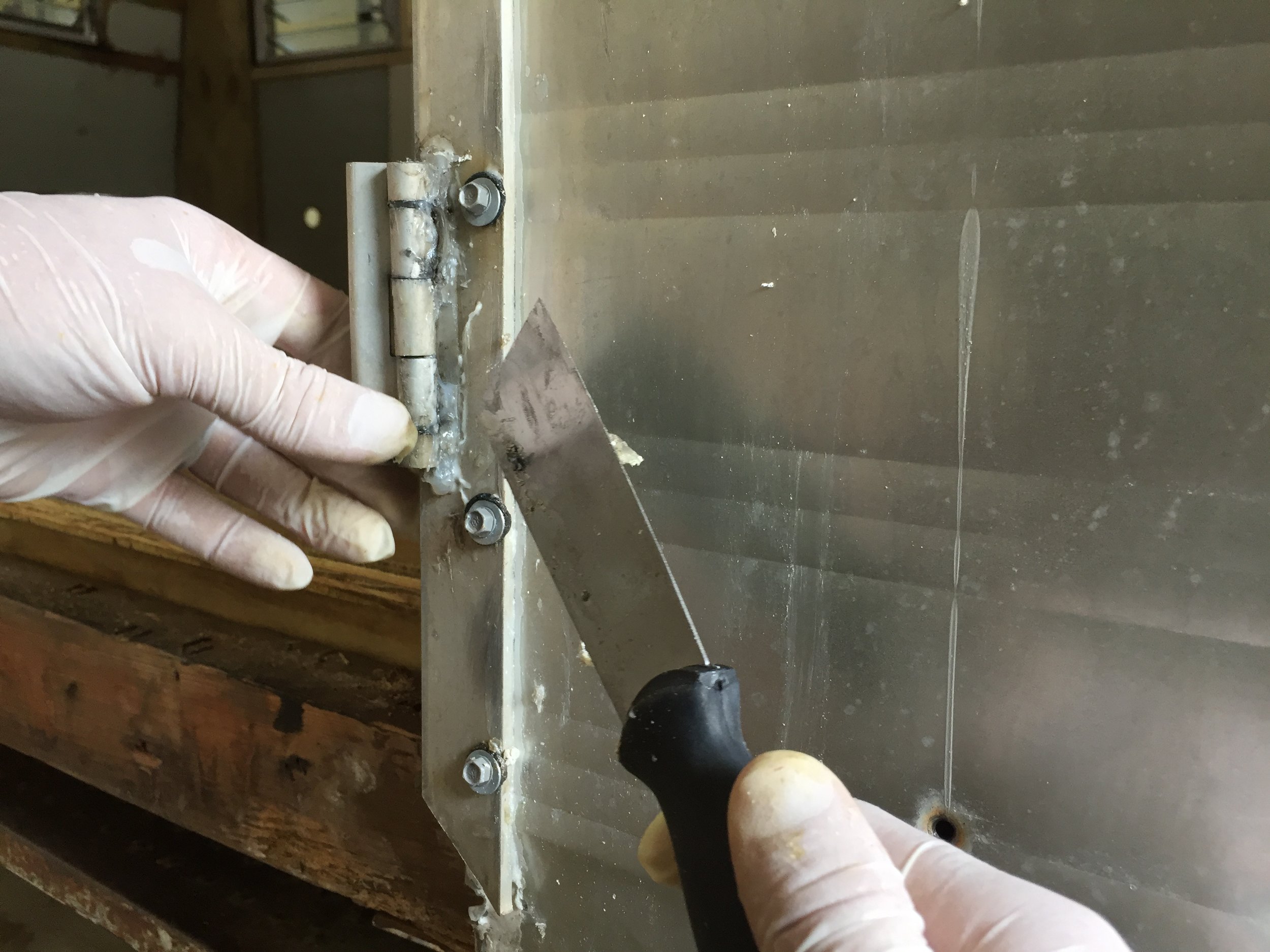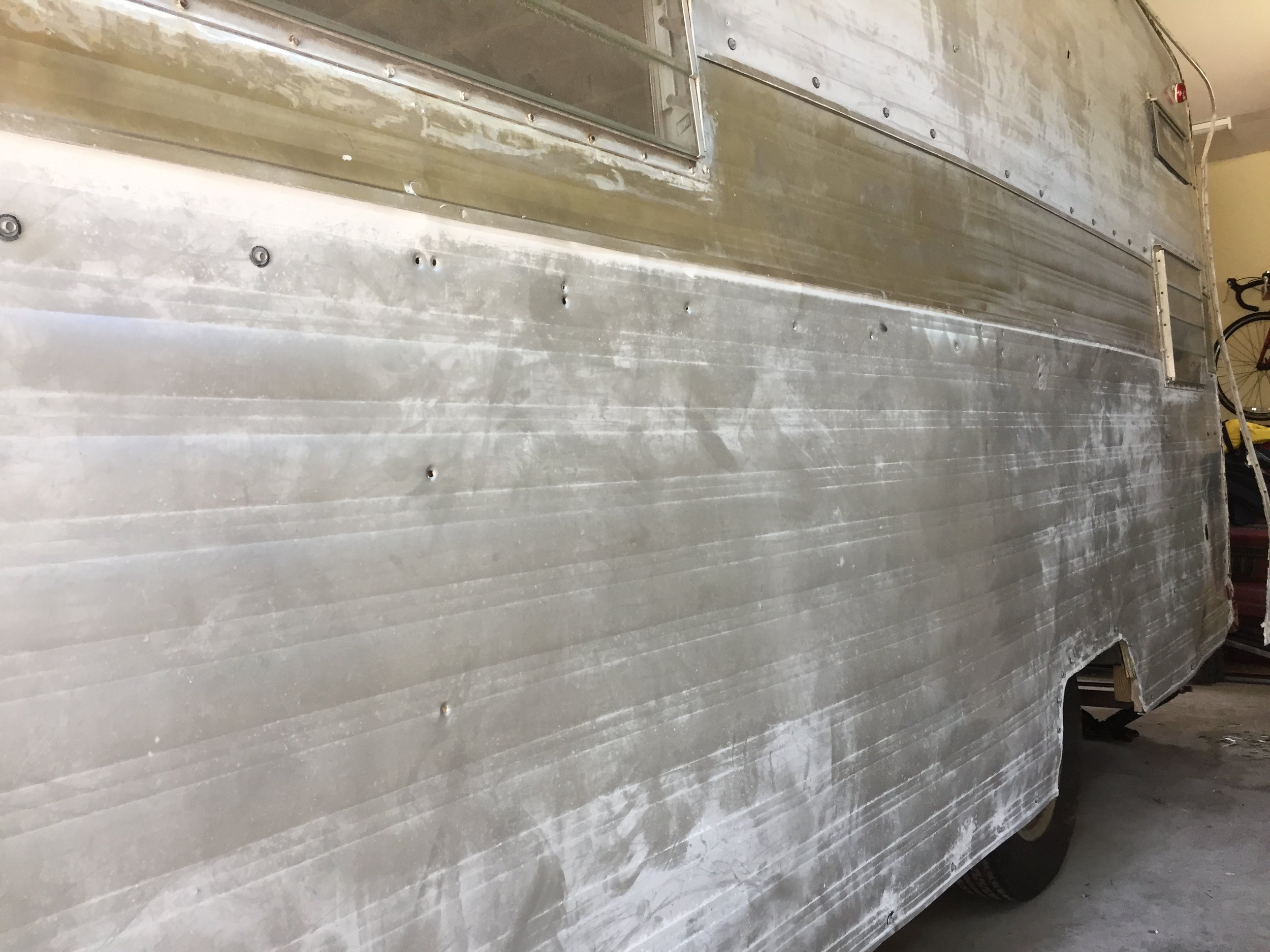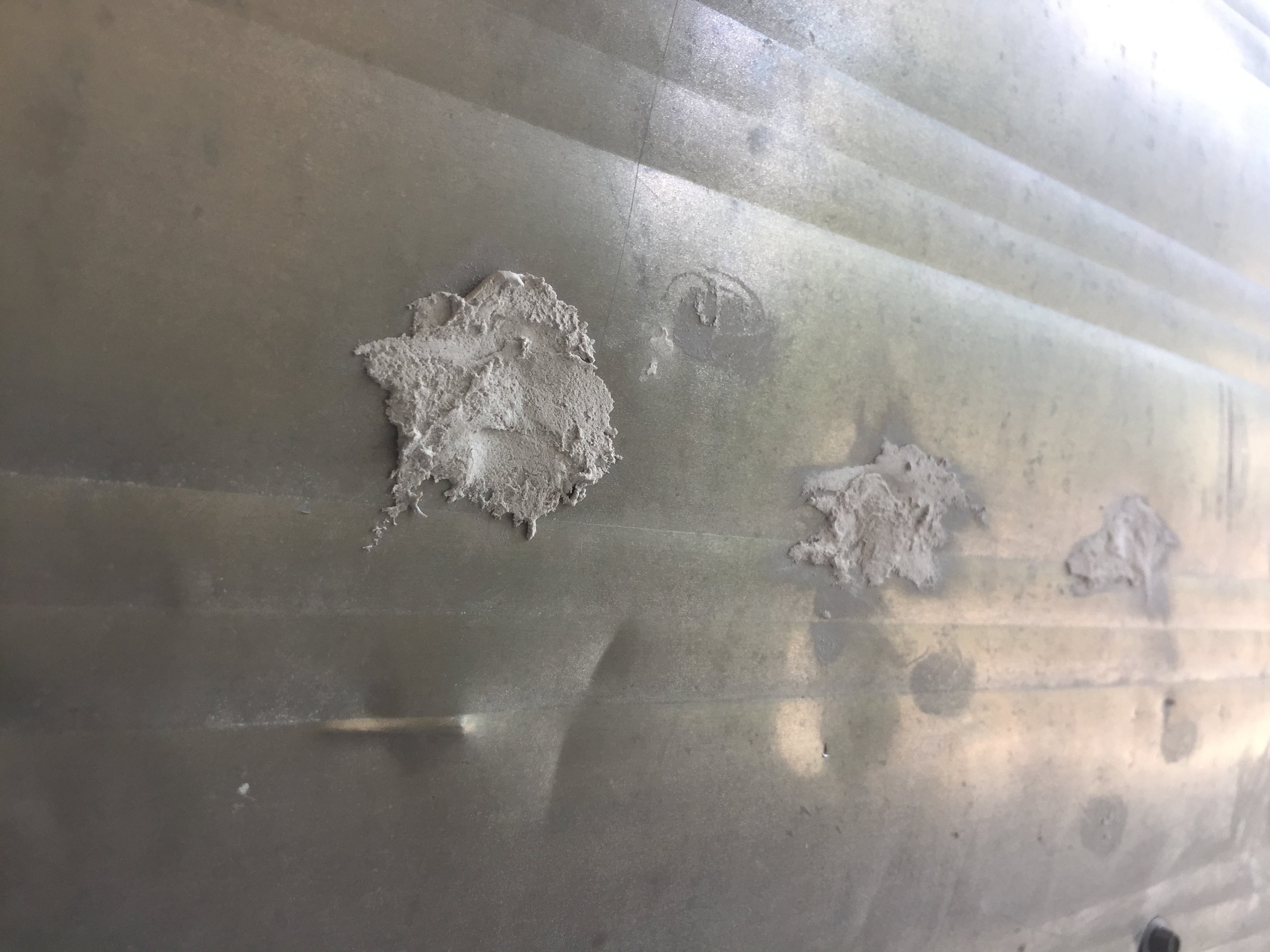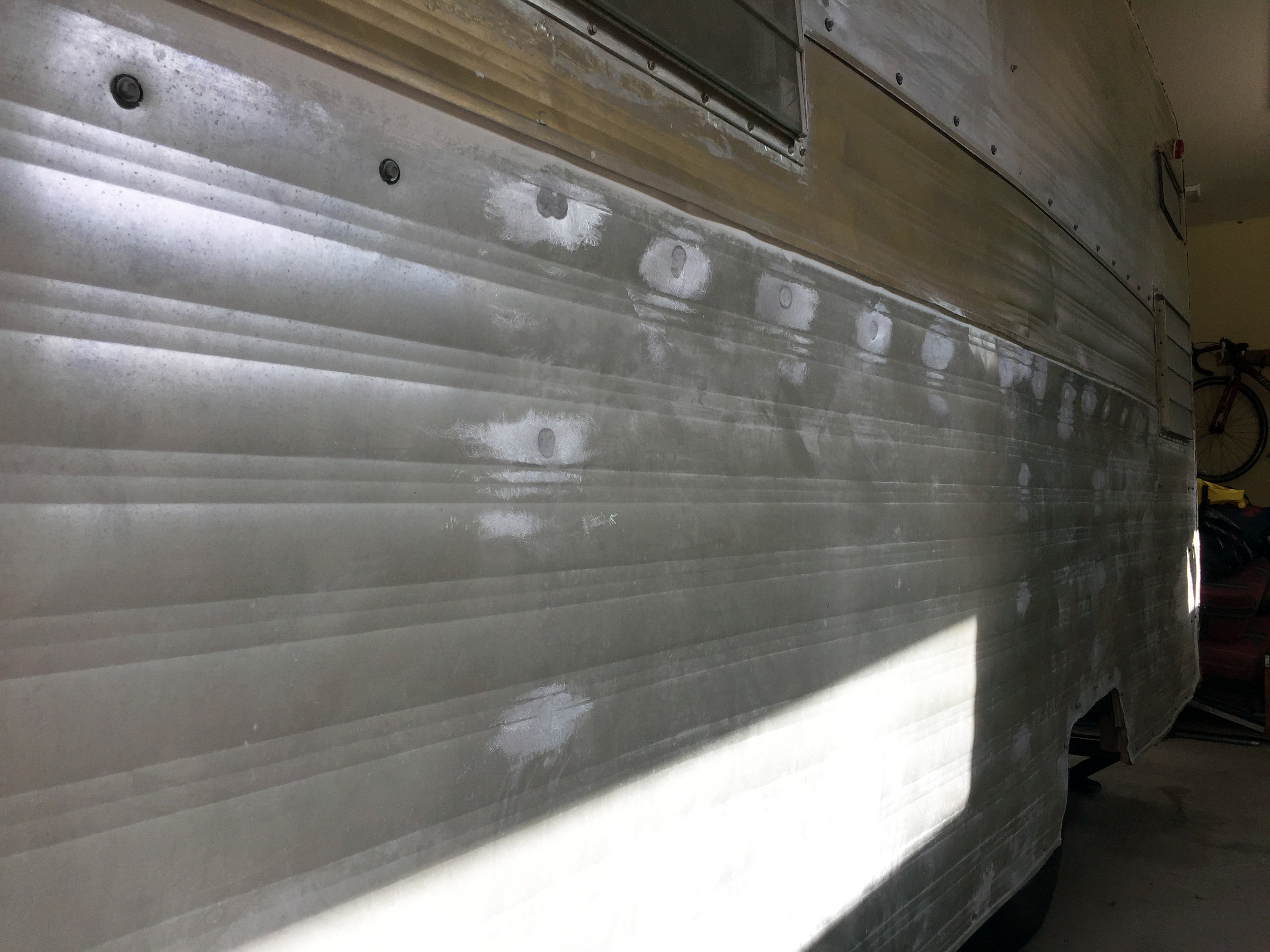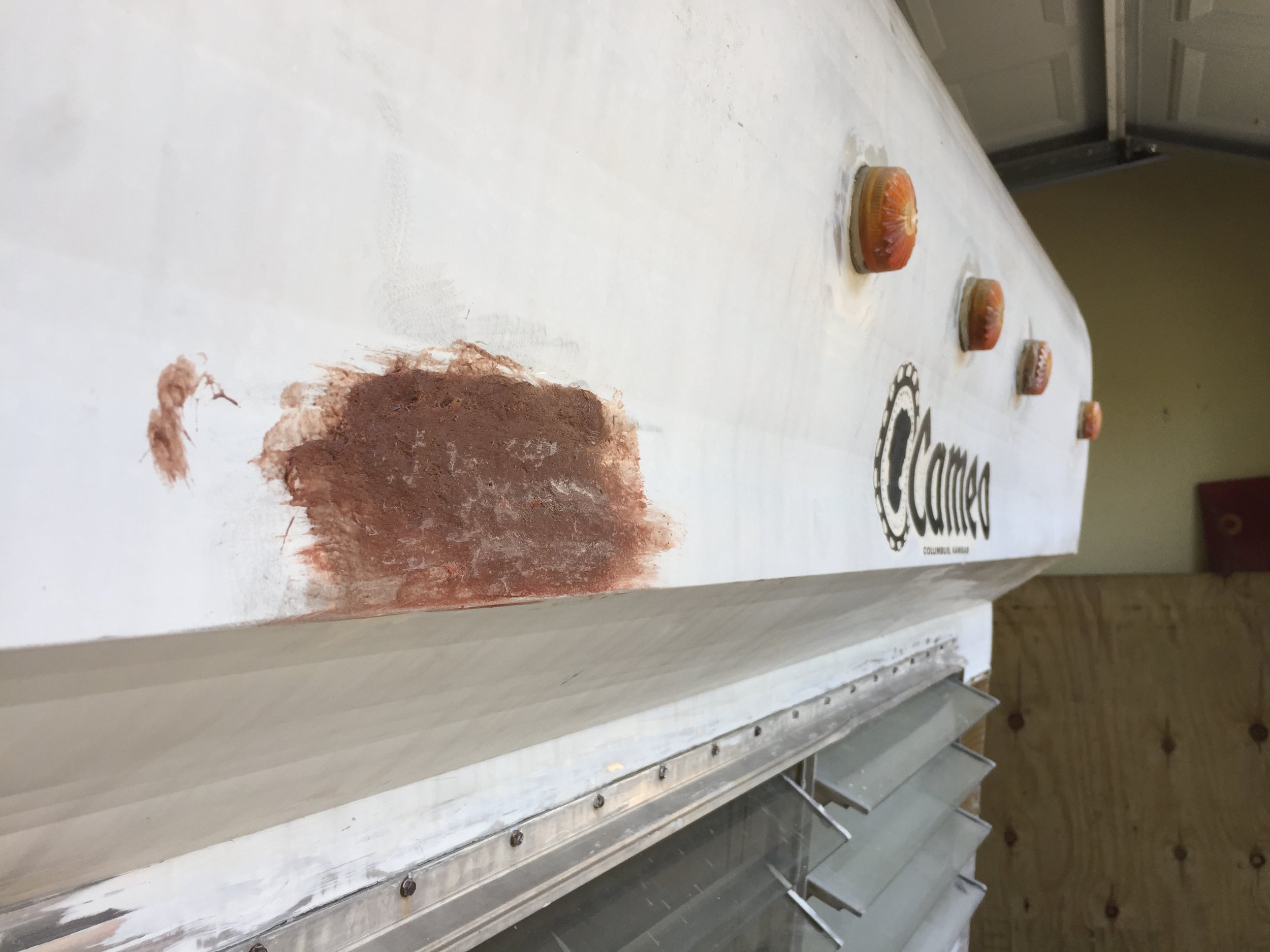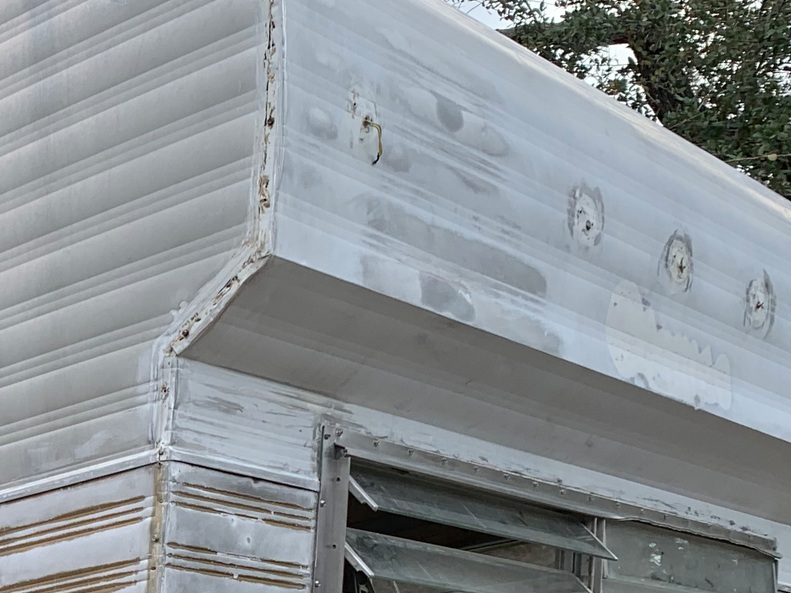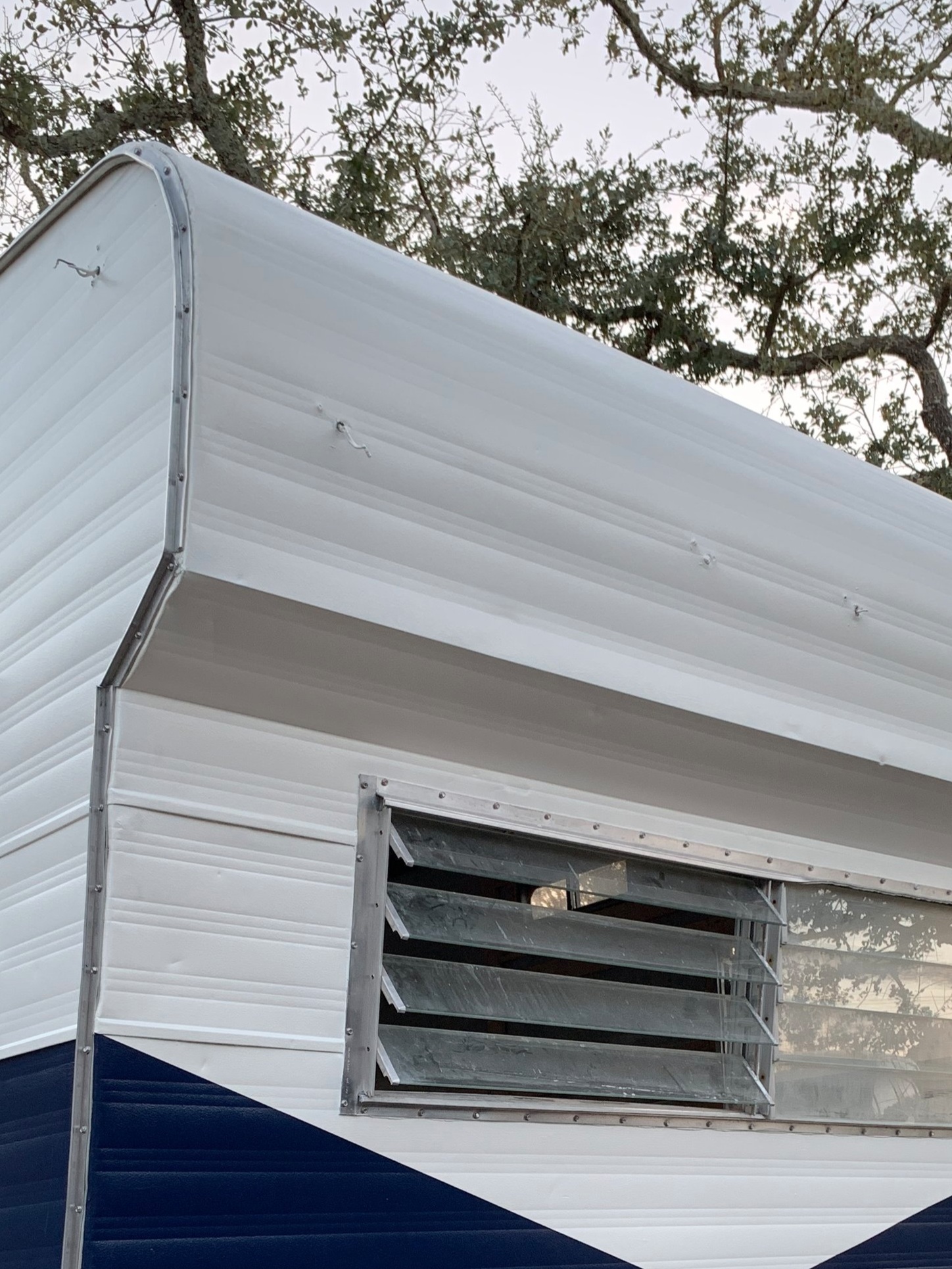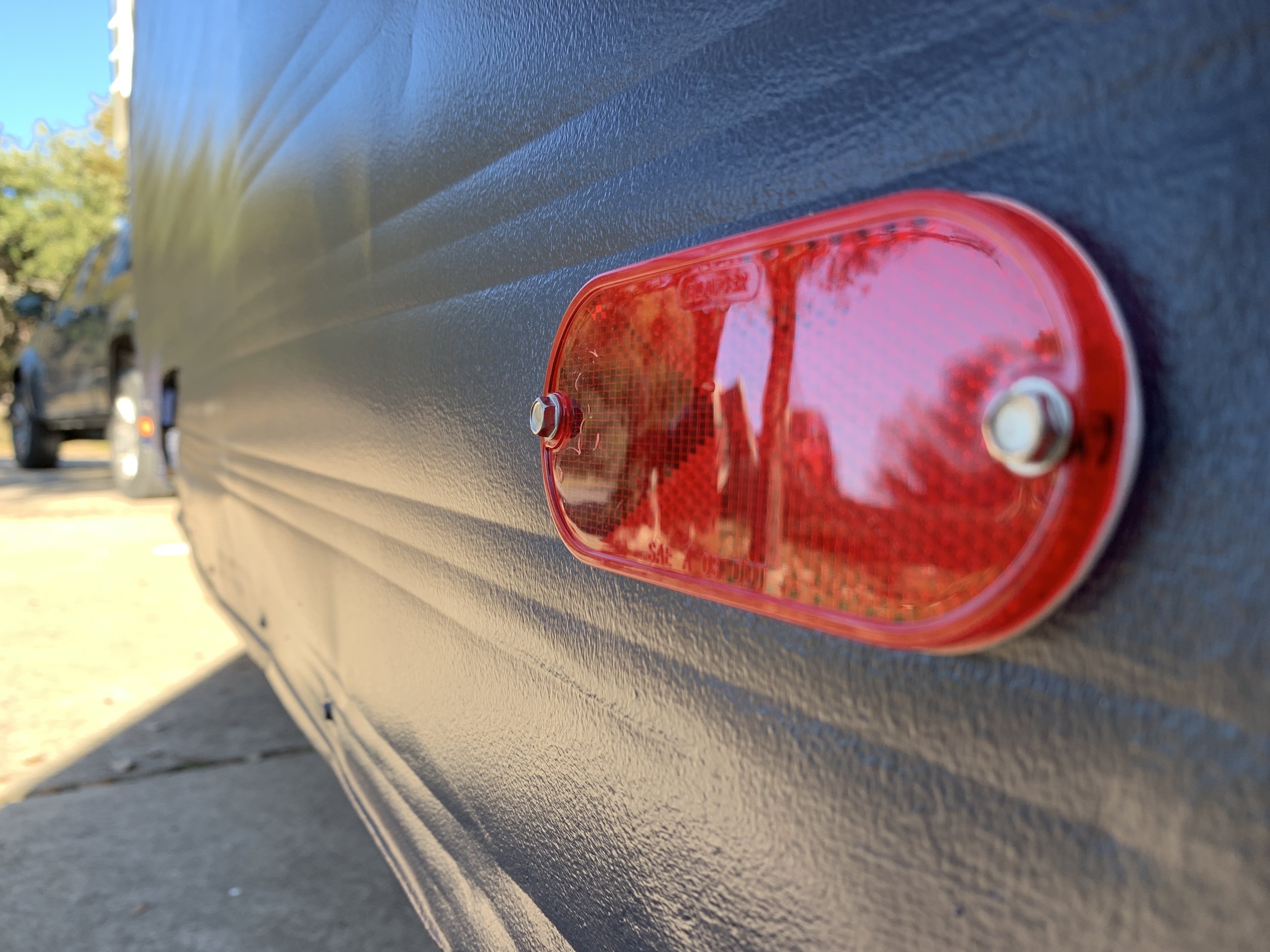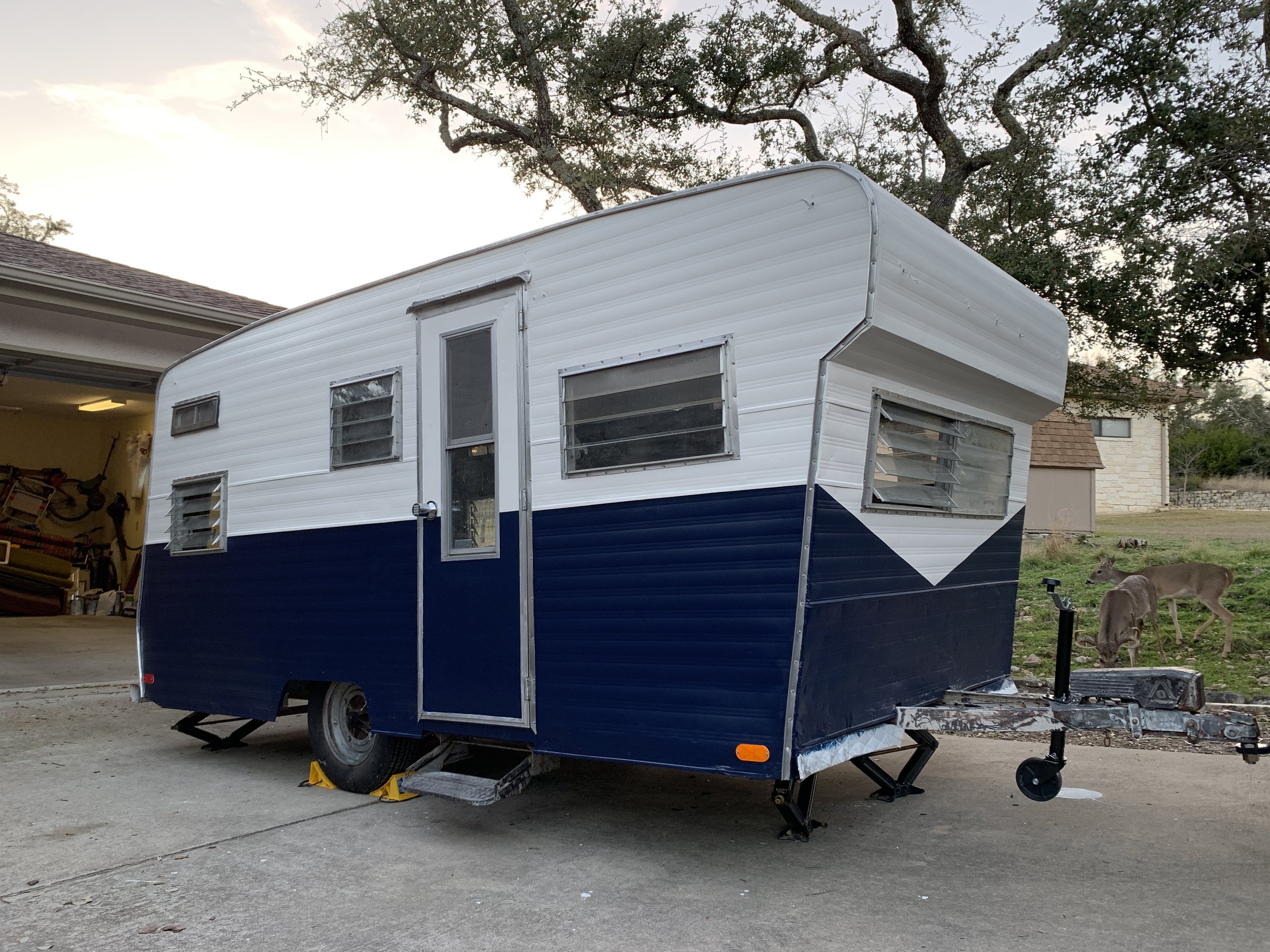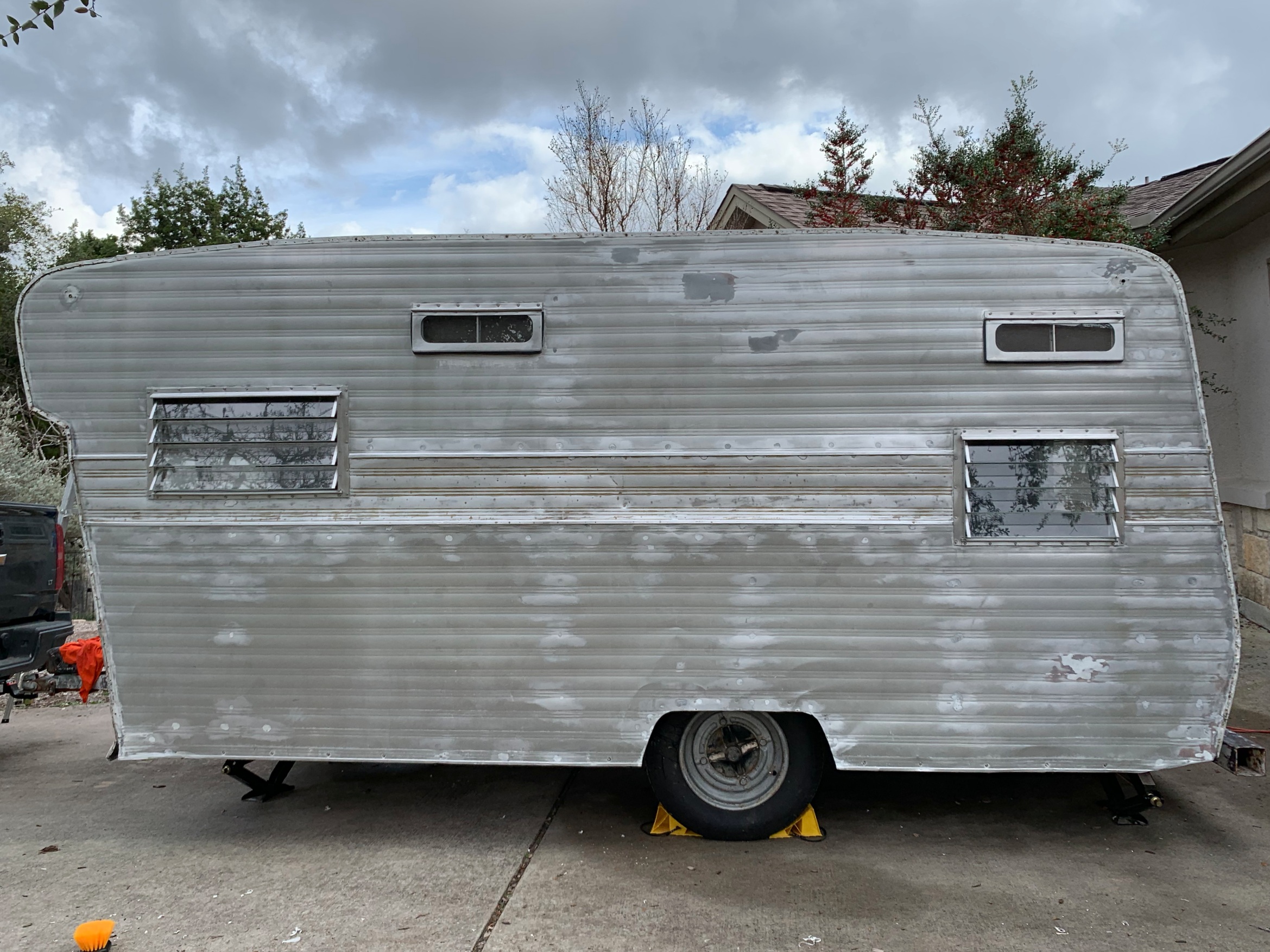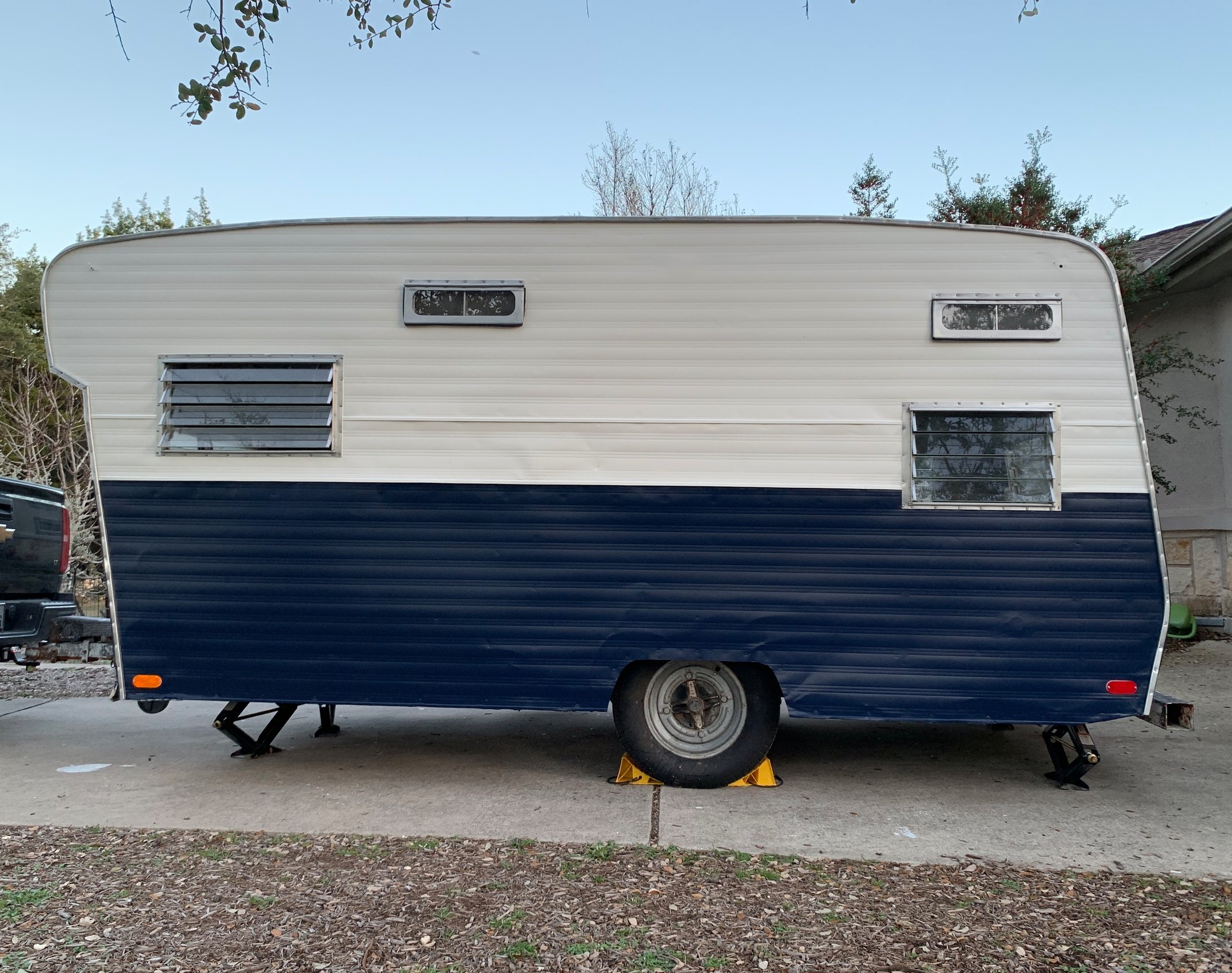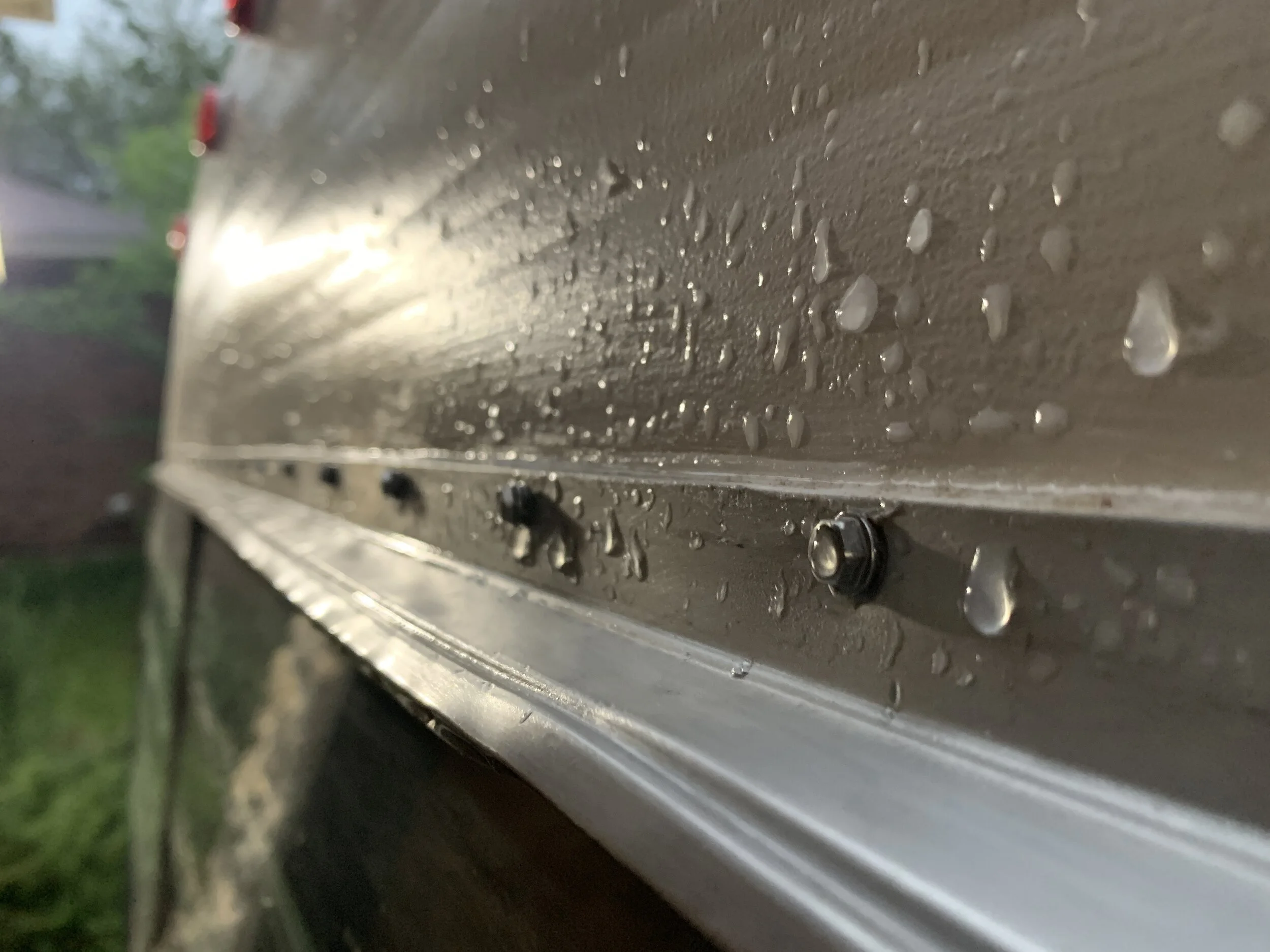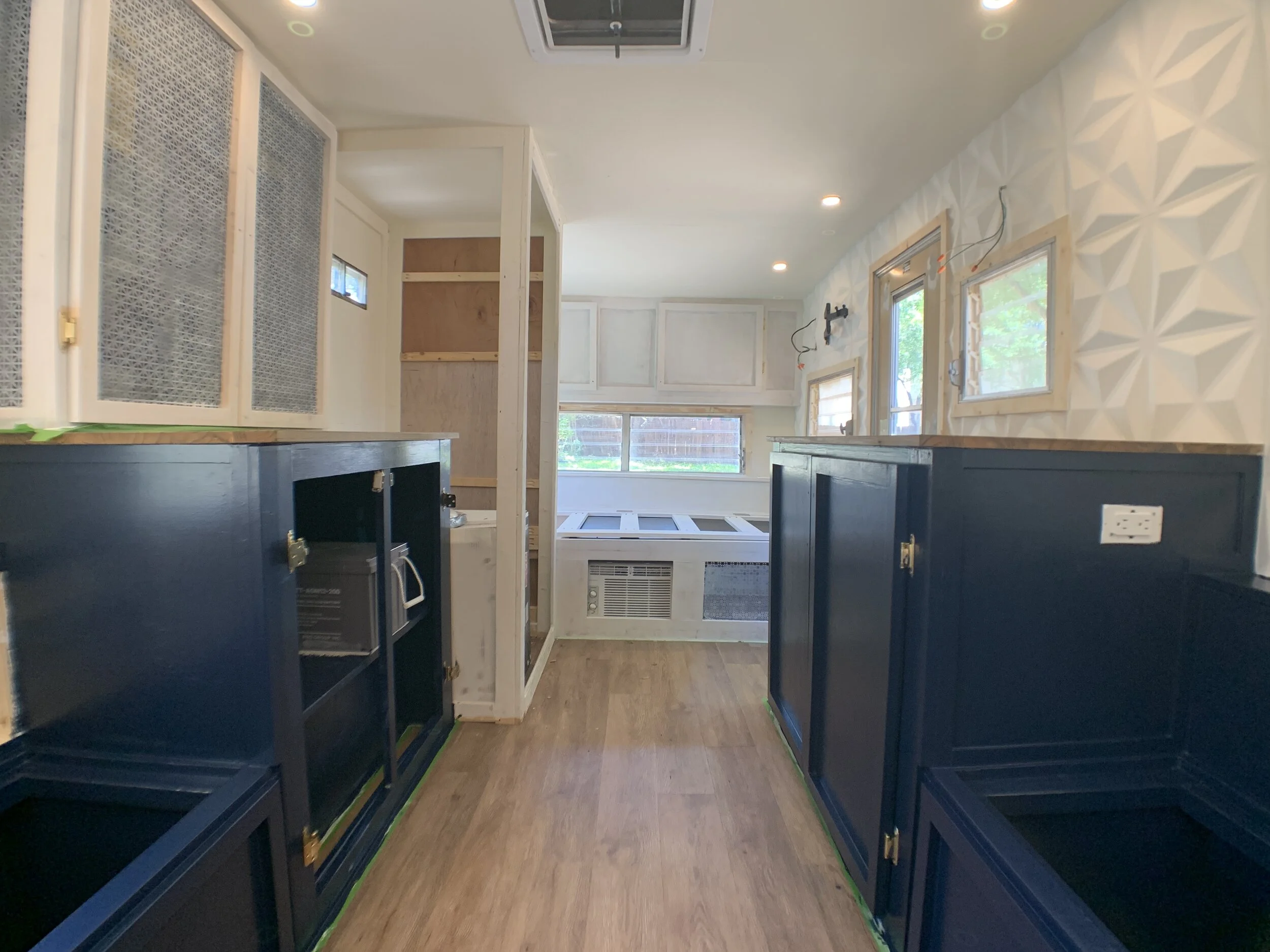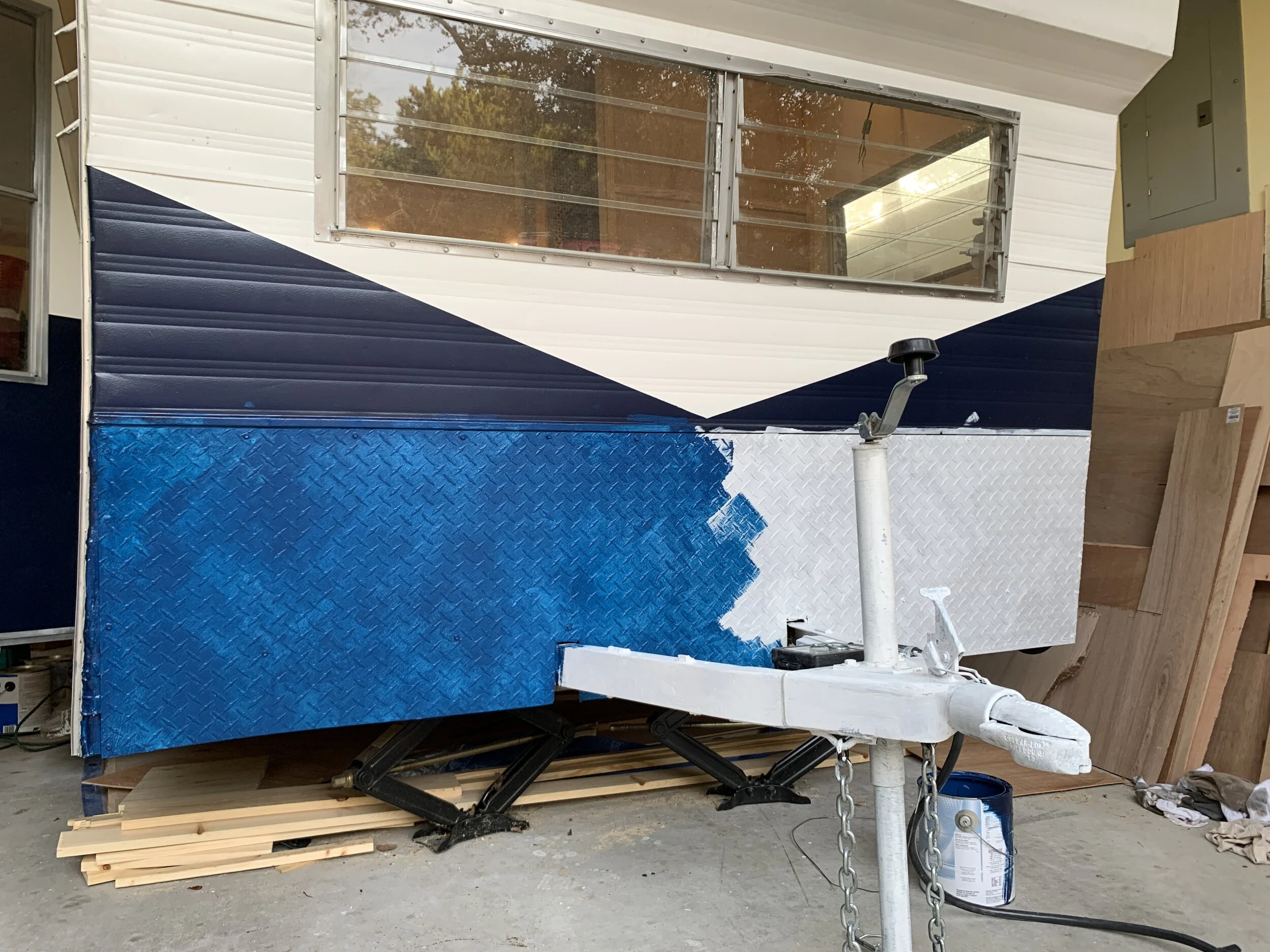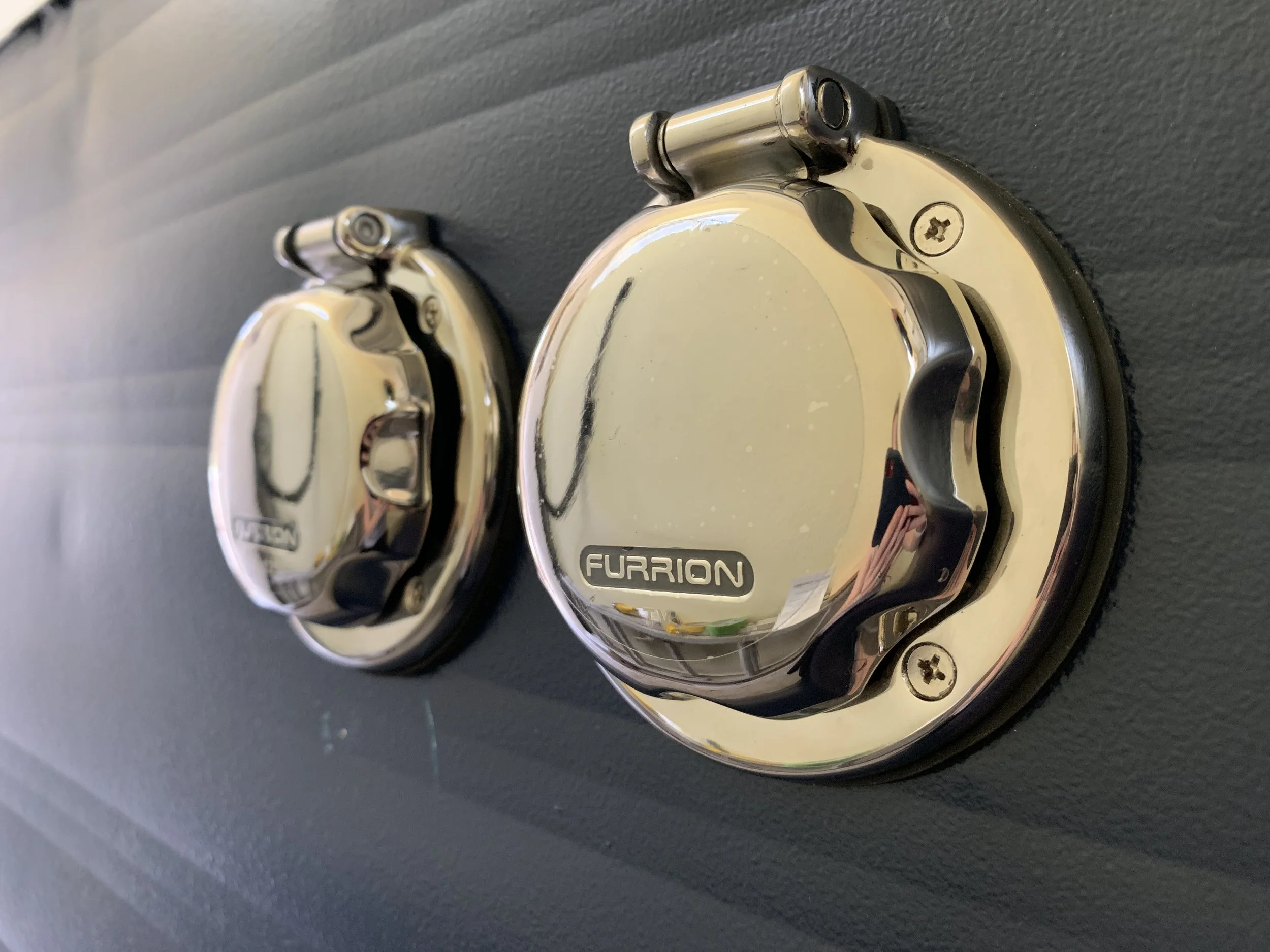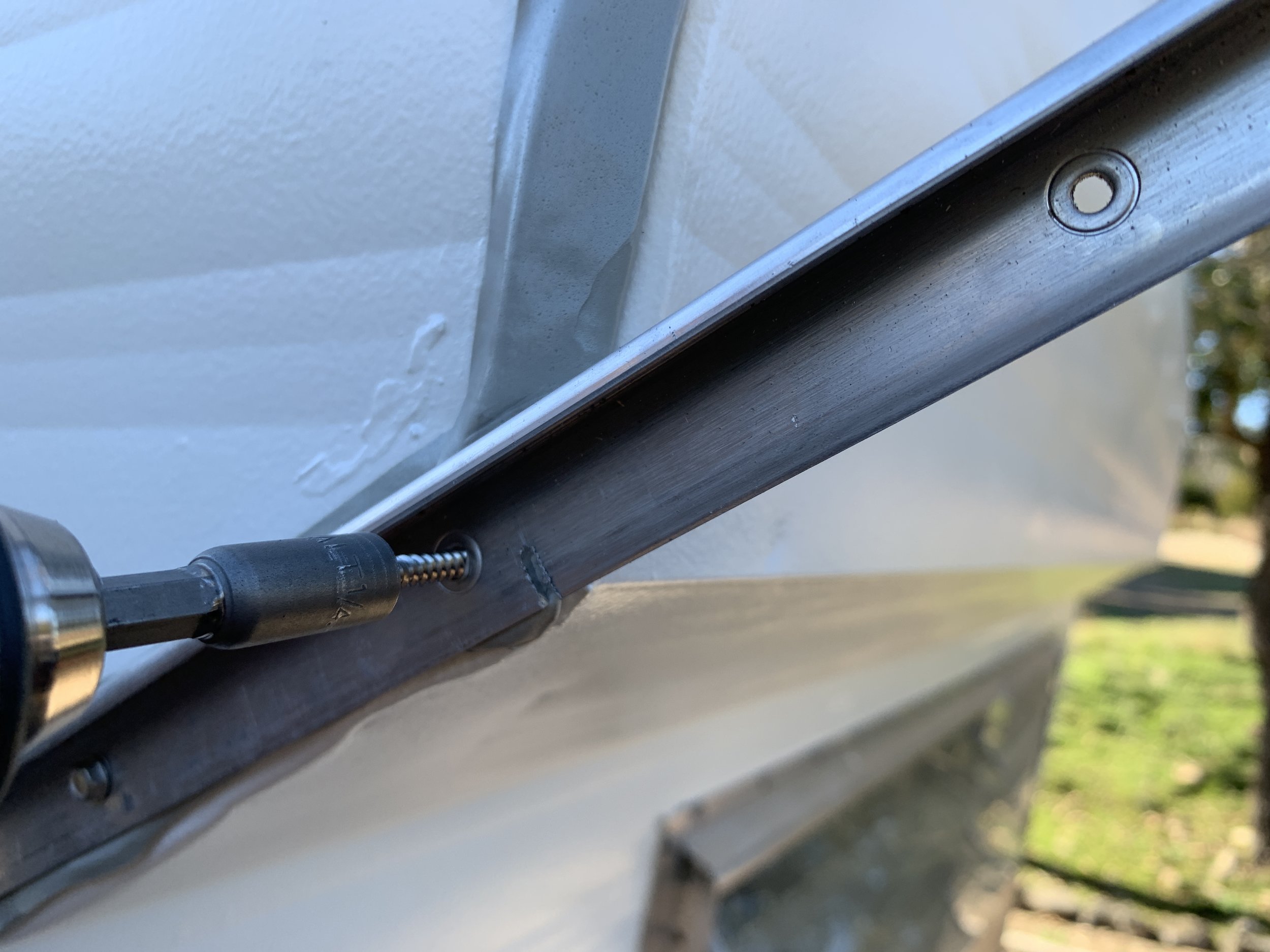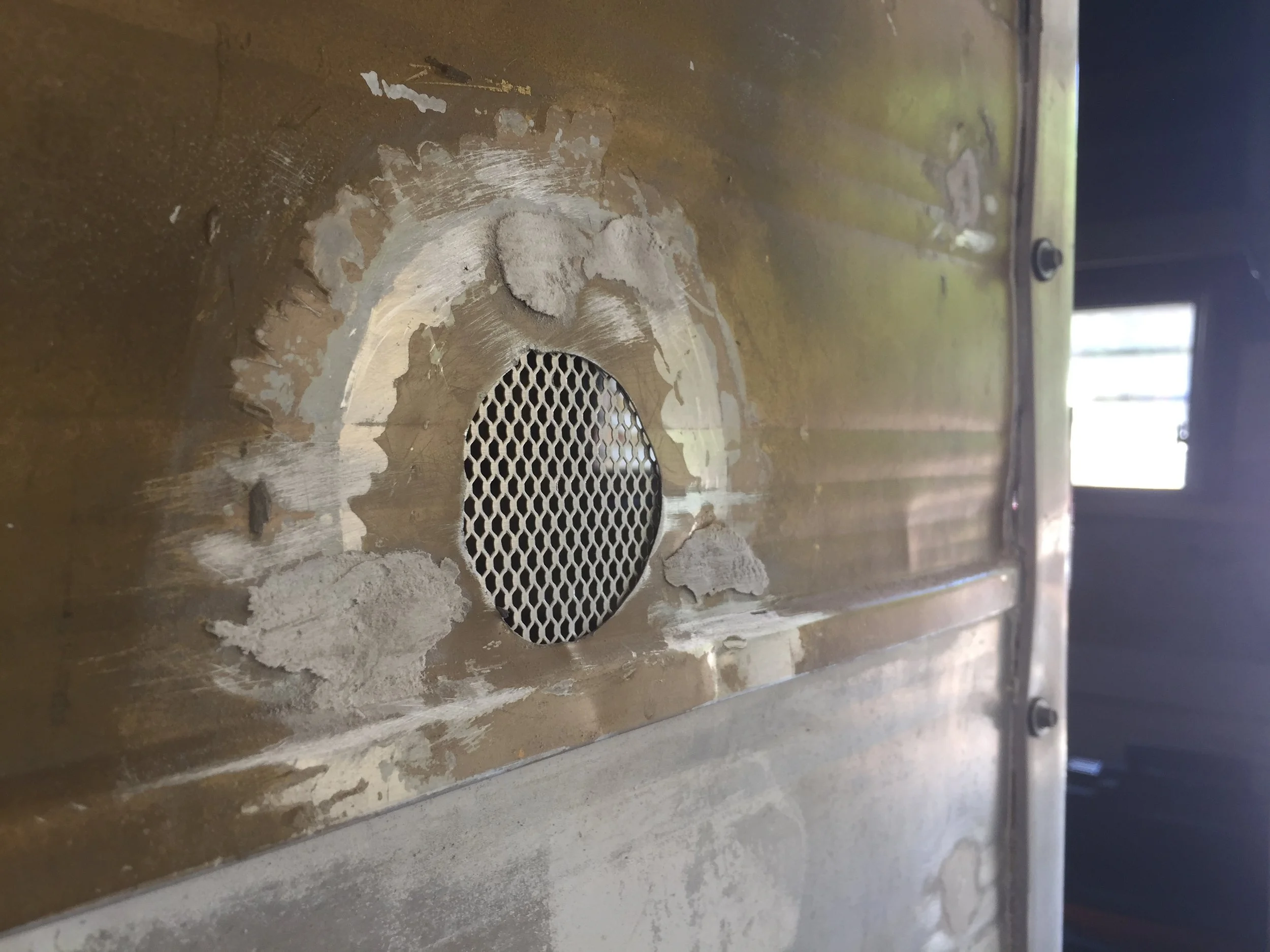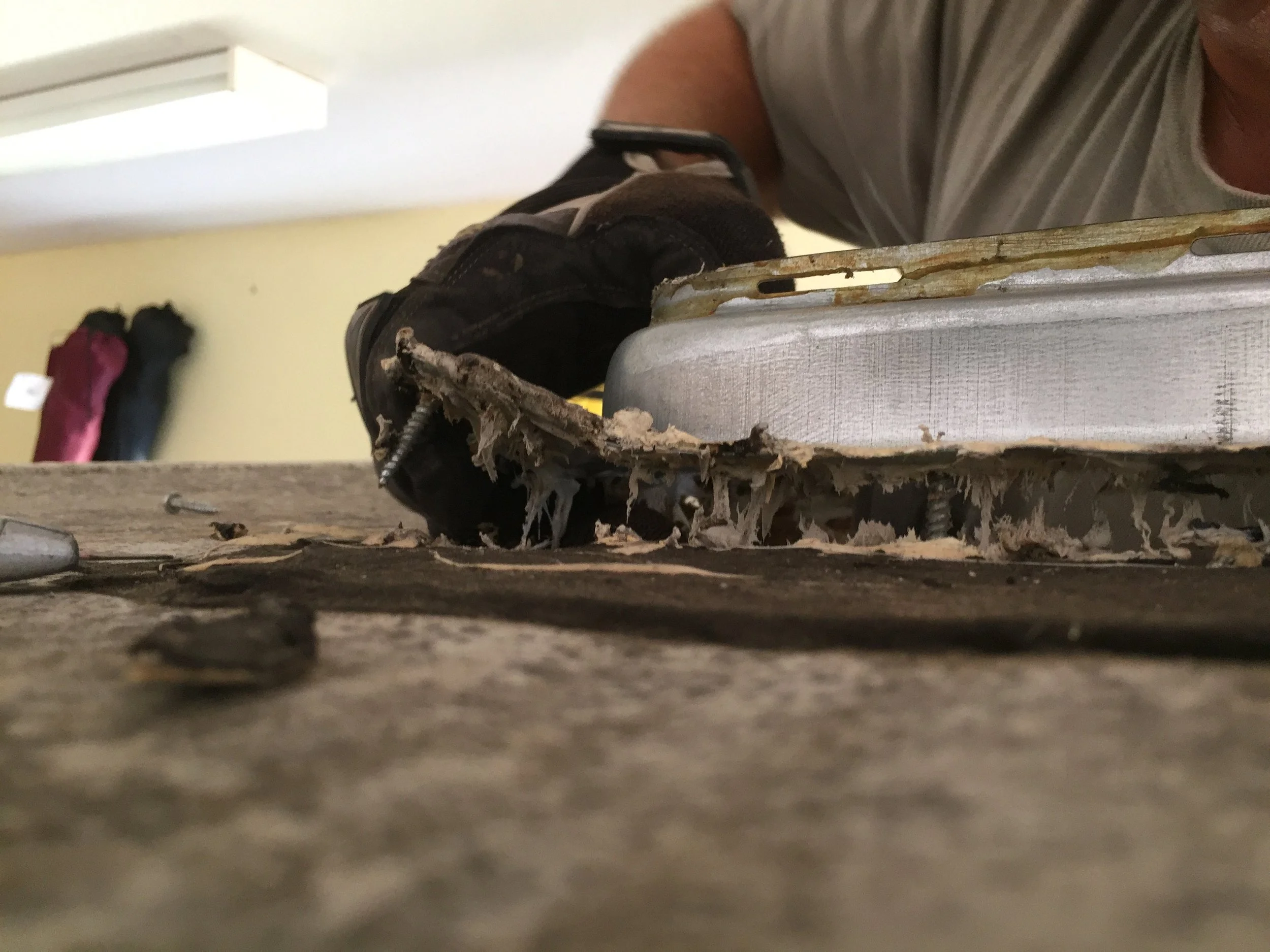The Cameo Camper Renovation: Repairing holes in aluminum exterior walls + prepping for paint
So. many. holes. Little holes, big holes. Skinny holes, fat holes. Round holes, ragged holes, wonky holes. If you can think of it, we had it. Some were intentional and functional – used for water and electrical connections, etc. Others were mysterious gashes and tears, no doubt collected on The Cameo’s many adventures. A lot, however, were made by us from that time we had to triage the camper so it wouldn’t come crashing down. Regrettable, but most importantly, repairable. All in all they added up to at least 128 holes (yes I counted, and I know I missed some). Instead of replacing the entire camper skin to make it watertight (which would definitely look fabulous, but is expensive and if we did that we figured we should’ve just built a new camper entirely from scratch), we opted to salvage the original metal exterior and repair the holes using various methods depending on the size, type and location.
I know she’s already all painted, and we kind of touched on this way back in August, but we repaired holes for so long and did so much more hole work since that post, that I felt this topic warranted another one with more details and tips for anyone attempting to do the same thing. Plus, a number of you have asked for details and I’m so happy to oblige!
For starters, do not fear – if we can do this, you can too! A lot of the holes were very sloppily plugged up with caulk or silicone or hot glue – most unattractive, some working better than others since there were still leaks all over this beast. It was a big ol’ hot mess that required a lot of caulk remover and scraping. A lot of the holes were incognito and don’t really show up in the very first photos we shared after we picked her up, but trust me they were there laying in wait…
The innies & outies of hole prep
After we removed caulk for days, we assessed what each hole needed, mostly based on its size. One thing to keep in mind is if your metal hole is poking “outward” so that you have little metal burrs, you’ll want to carefully push them so that the edges of the hole pull in. In our case, when we removed all of the screws we’d put into the walls, it pulled the metal a little creating what I’ll call an “outie” belly button. In the case of patching holes, we found an “innie” works better. You can see what I’m talking about below.
In the outie photo on the left you can see the metal burrs around the holes, compared to how smooth the edges look after we made them innies in the photo on the right. (The larger ring you see around the holes on the left were made by the foam washers on the Teks screws we used. They are slightly indented into the metal.)
We turned our outies into innies by using a combination of a flathead screwdriver and a pair of needle nose pliers. And lots of muscle. And grunting. I’m pretty sure I was grunting. I’m not gonna sugarcoat it – this part sucks. It takes a fair amount of hand strength and precision to move the metal without slipping and scratching the metal up or stabbing yourself. (No one’s perfect – if you slip and scratch your aluminum a little you can always sand it out with fine sandpaper before painting and no one will be the wiser.) I recommend wearing gloves to help cushion your hands and protect them against the metal just in case you slip. Our technique was to start with the screwdriver to fold over any extra pokey bits as much as possible, then use the closed tapered needle nose end of the pliers to pull the hole inward by sticking it in the hole and kind of swirling it around. (Not sure there’s a better way to say that, so insert joke here.) Even though it takes a little while and makes the hole a little bigger, this step gets you a smoother finish when you go to sand later, not to mention is safer when you’re applying the putty by hand since you’re not poking yourself with metal burrs. Once they’re all turned inward, you’re ready to fill.
Small holes (about 1/4” in diameter or less)
Small holes in the process of being filled with JB Weld Water Weld
Tools for the job:
Disposable gloves
Electric sander + varying grits of sandpaper (we used 80 - 240)
I’m pretty sure JB Water Weld Epoxy Putty was invented by some kind of wizard. This stuff is amazing. According to their website, “WaterWeld will plug or seal leaks and patch holes and cracks in almost anything. Ideal for repairing plumbing, fuel tanks, tub and shower, drains, pool and spa, boats and potable water tanks; setup occurs even under water. After curing, it can be drilled, tapped, filed, sanded and painted. WaterWeld has a set time of 15-25 minutes and sets hard in one hour. WaterWeld cures to an off-white color, is rated at a tensile strength of 900 PSI and will withstand temperatures up to 300ºF." Great for:
Plumbing, Tub, Shower & Drains
Fuel Tanks
Marine & Boats
Potable Water Tanks
Vintage aluminum campers! (alright, I added this one, but it does say “metal”)
We went through I’m guessing about seven sticks of this stuff over the course of this portion of the renovation. What’s great about JB Water Weld is it’s very easy to work with, waterproof, paintable and sets up pretty fast so you can get it applied pretty quickly. That being said, because it starts to harden quickly once mixed, it’s best to work with pretty small amounts. It looks like a little putty log (maybe about 4” long or so) and is made up of two parts – a gray colored inner core and a white outer part. I don’t know what exactly it is, but you have to mash the two parts together to activate the stuff. You’ll know you’re doing it right because it gets warm (not hot enough to burn you or anything) and the two colors should mix to make a uniform light gray color.
Wearing disposable gloves, I found it best to unwrap it from the plastic, and just break off a small amount (maybe about 1/2-3/4” or so), making sure to break off the end in a straight line so you get the right amounts of the core and outer parts. Squish it with your fingertips (wearing disposable gloves!) until it’s warm and the color is mixed thoroughly. Then quickly apply your glob of putty on top of and beyond the edges of your hole, which should always be a clean, dry area. At first I tried to nicely feather the edges off and flatten the top as much as possible to help with waste and minimize sanding later. Doing this sometimes meant I hadn’t put enough JB Weld on and after sanding I had a little dimple where it was still low and I had to go back for another repair. Good news is you can layer this stuff if needed to get just the right height and look you need.
After it set, I sanded the sloppy lumps down getting finer and finer with my grit each time until I was happy with the smoothness and how the edges feathered into the surrounding aluminum. I thought it sanded better the next day or longer out after application. In our experience we knew we’d tried to sand it too soon when the top started turning a weird dirty gray color, almost like it was just burning/melting a little or something. Occasionally I would sand the stuff too thin (for the size of the hole I guess), and the vibration from the sander would rattle the JB Weld right out of the screw hole I’d just patched. A total bummer, but I’d just layer on top. Sometimes with more JB Weld, and sometimes I’d try something else…
Large holes (1” or so in diameter & up)
Large holes – the one on the right is shown with the Bondo self adhesive patch in place behind it.
Tools for the job:
Bondo – we used both stranded and non-stranded
Bondo self-adhesive patch (or sheet metal) so the Bondo has something to grip to
Duct tape (maybe)
Disposable gloves
Non-porous surface for mixing Bondo
Electric sander + varying grits of sandpaper (we used 80 - 240)
Bondo. This stuff is kind of a mess. Okay, really a mess, but it does make for such a nice finish it makes the smell, look and mess worth it. Not knowing which would be better for us, we bought and tried both the stranded fiberglass and non stranded metal-infused types. They both worked well, but I’d recommend the non-stranded. It was less messy, stunk way less and was easier to apply overall. Follow the instructions on the containers for your hardener ratios and mixing techniques – they’re strange but they’re important. The stranded seemed to harden up quicker, and (wearing disposable gloves) I mixed and applied it by hand smearing it around as needed. Like the JB Water Weld, this gets warm to the touch as the hardener is activated.
The non-stranded Bondo was mixed and applied with a plastic spreader which made it easier to smooth as I went. This one also sets up very quickly so resist the urge to smooth it too much because it will just make it uglier and more textured. Trust me. Because it goes on with a spreader, I was able to more easily mimic the striped texture of our camper by kind of scoring/waving the plastic spreader as I was applying it.
Once cured, I sanded these patches down using finer and finer grits as I went.
For the patch above we added and sanded a layer of non-stranded Bondo in between photos three and four.
For very large holes that need some kind of backing, use the Bondo metal self-adhesive patch (or a scrap of sheet metal glued to the backside of your hole, like we did for the front of our camper). The patch is meant to be cut to size, if needed, and is supposed to stick to the surface you’re patching. For some reason ours didn’t. Thankfully we applied ours on the inside of the camper for a smoother finish, so we used duct tape from the back to help keep the patch in place. Smoke and mirrors, y’all.
Tiny holes (pinholes much smaller than 1/4” in diameter) & fine tears
Tools for the job:
Bondo – we used both stranded and non-stranded
Non-porous surface for mixing Bondo
Disposable gloves
Electric sander + varying grits of sandpaper (we used 80 - 240)
They may be small and unassuming, but we’ve found the smaller the hole, the harder it is to patch. These are the ones when as you’re sanding, the filler is most likely to jiggle and wiggle and somehow fall out. In many of our “problem areas” where the metal was riddled with tears, baby holes and those weird fuzzy looking worn holes all right next to each other we used a multi-faceted approach, combining all the techniques used in the sections above. When in doubt, fill it, sand it, then fill and sand it again a few more times. There may be a better way to do this, but we just had to layer and layer and layer filler in these areas since we had just about everything happening in the span of a foot or so.
An added layer of waterproofing, just in case
We think these areas are all watertight, but as an extra measure we will be rounding back to all of our previously leaky areas with a bottle (or two) of Captain Tolley’s Creeping Crack Cure. We don’t want all of this hard work to be for nothing, so if a tiny bottle of miracle sealant is enough to push us over the waterproof edge, we are all in!
It “finds and fixes mystery leaks without having to take everything apart. It is a one-part water-based acrylic co-polymer penetrating sealant. The Creeping Crack Cure is so thin that using capillary action it can find its way right inside fine seams and joints to set to a clear flexible seal. It is a totally different approach than most sealants. Being thinner than water, it goes where the water goes. It can find its way right into hairline cracks and hair-thin seams where other sealants cannot reach. It traces mystery leaks. The rapid absorption of the sealant into the seam indicates the potential leak. Even excellent conventional sealants cannot do that. It's quick and easy to apply, too. There's no need to remove old sealants. You just apply the sealant along the line of a crack or joint until no more is absorbed. As an added benefit, it’s water-based and non-toxic. The sealant is safe to use and, unlike other products, it can be applied to cracks even when they are slightly damp. When dry the sealant is transparent but it can be painted over successfully as so little of the sealant is exposed to the surface.”
After Captain Tolley’s, we’ll be adding a thin bead of silicone to the seams as well. This may all be overkill, but then again if it keeps us from having any more water damage, it will have all been worth it.
Removing paint + sanding imperfections
Tools for the job:
Electric sander + varying grits of sandpaper (we used 80 - 240)
This step was the easiest for us paint prep-wise. The Cameo was mostly bare and really only had the gold stripe on it. The gold paint was in pretty good shape in that it wasn’t chipping, but when I started running our electric sander over it, it did start to kind of flake off a little. I probably didn’t have to sand off quite as much as I did, but my inner OCD monster got a tiny bit carried away. That being said, you can see from the photo above we didn’t get every speck of gold off. Instead, we just made sure the loose bits came off and everything that was left was smooth and primer-ready.
If you have a few holes to patch, don’t worry. You can fix it. Just look at how many patches we had just a couple weeks ago (at least 128), compared to now. What holes?
She’s not perfect, but this old gal has seen some things in the last half a century.
Make that 129 holes…
Since I started writing this/after we painted the exterior, I accidentally screwed a Kreg screw through the outside of the camper skin when trying to add a piece of wood to the inside of the left rear area.
::: facepalm :::
So, for now I have at least one more hole to patch. Everything’s fine; nothing is ruined. We’ll just add it to the list.
What do you think? Any questions for us? Suggestions on what you’d like to see?
For the latest on The Cameo – plus pictures of our pups and some other shenanigans – don’t forget to follow us on Instagram. We’re getting so close to moving to the inside I can almost taste it!!

